New research by RMIT urban experts on low-carbon housing in Horsham has found that households could be better off by A$1,000 per year and boost their health and living conditions.
At a time of rising stress over high energy costs, especially among low-income households, the study led by RMIT’s Centre for Urban Research (CUR) reported that low-carbon houses in comparison with ‘standard’ residences in the north-west Victorian town, provided better financial relief.
Lead author Dr Trivess Moore from CUR said that although low-carbon housing is considered best international practice, it is still perceived as expensive as most housing standards studies only rely cost-benefit analysis (CBA) to assess their value.
Horsham Catalyst Research and Evaluation, conducted by CUR and funded by the Victorian Department of Health and Human Services (DHHS), illustrates how such analysis fails to take into account flow-on financial benefits such as reduced energy bills and lower mobility costs, overlooking the effects on householders’ health and quality of life.
Moore says that DHHS wanted the research team’s evaluation of its Horsham properties to examine a range of economic, social and environmental elements.
“Our study clearly shows that the housing sector’s over-reliance on CBA may be ignoring some important health benefits of different housing arrangements, particularly for low-income tenants,” he said.
“Households living in the Catalyst houses reported they had extra spending money for Christmas presents, personal debt or holidays due to low utility bills, with one household reportedly permanently removing itself from all Centrelink payments due to the amount they saved.
“These savings strongly contributed to reduced stress and better mental health for tenants.”
The project conducted a multi-year evaluation of four new two-bedroom, single-storey, low-carbon designed public housing units with a National House Energy Rating Scheme rating of 8.9 stars (Catalyst houses) in addition to seven one-and two-bedroom Control dwellings.
The Catalyst houses were found to perform substantially better overall compared to the Control DHHS dwellings on key measures such as power and water consumption, environmental performance and thermal comfort in a region known for its climate extremes.
“DHHS can now use the report to validate the sustainable elements that deliver the best social, financial and environmental value in low-density public housing, and also better inform the housing sector about the link between green homes and tenant’s health,” Moore said.
View the full report online.
For interviews: Dr Trivess Moore (03) 9925 9071 or 0408318182
For general media enquiries: Chanel Bearder (03) 9925 0917 or 0432140673.





